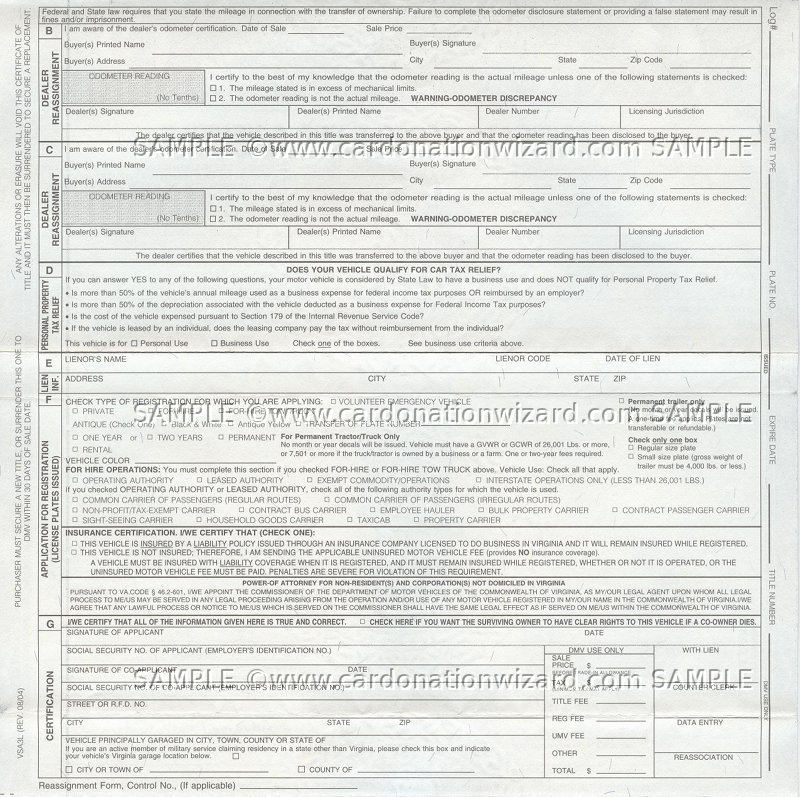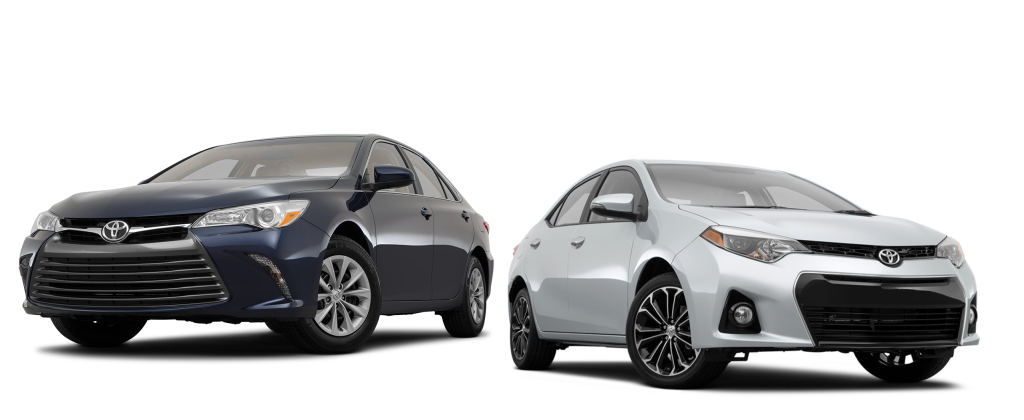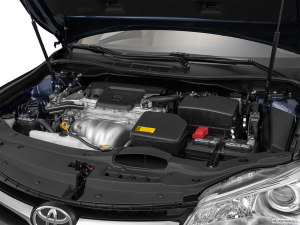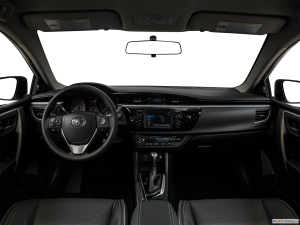Before a vehicle becomes a Toyota Certified Used Vehicle, it must pass a comprehensive 160-point inspection. Certified Toyota mechanics checks every inch of the vehicle to make sure that your Toyota dealer has only the highest quality used vehicles available. So here’s what’s on our Toyota Certified Used Cars checklist.
Powertrain
The heart of the vehicle beats in the Engine Compartment:
- Change engine oil and filter
- Check for evidence of sludge
- Inspect for fuel, oil, coolant or other fluid leaks
- Engine cold high idle correct
- No abnormal engine noise at cold start
- Throttle does not stick shut on cold start
- Drivability OK during warm-up
- Hot drivability OK
- Engine reaches normal operating temperature
- Engine fan functions properly
- No excessive drone or vibration from engine
- Drive belts and hoses free of cracks or damage
- No damage to engine mounts
- Check under-hood labels and decals
- Engine compartment is clean
- Under-hood heat insulator pad is clean
- Engine free of excessive dressing
- Inspect air filter
- Oil, brake, clutch, transmission, transfer case, washer and power steering fluid levels OK
- Under-hood fluids clear and uncontaminated
The Transmission and Transaxle are evaluated for proper performance:
- Transmission/clutch operates smoothly
- Automatic transmission in “ECT” power mode shifts properly
- Transmission gear ranges engage promptly while shifting when warmed up
- Transmission shift lock and key interlock system OK
- Transmission does not shift into overdrive when button is in OFF position
- Inspect transmission case and pan for leaks
- No damage to drive and axle shafts
- Differential fluid level correct
The Engine Coolant and HVAC System keep the car and its future owner cool and composed:
- Engine coolant at proper hot and cold levels
- Coolant specific gravity to -31° Fahrenheit
- A/C cooling operation normal
- A/C refrigerant sight glass clear
- Heater operation normal
Operation
A thorough inspection of the Braking System ensures everything is in top condition:
- Inspect brakes, calipers, lines and hoses
- No excessive vibration during braking
- ABS operates on “panic stop”
- Parking brake sets and holds vehicle
- Brake pads/shoes must have minimum of 50% wear remaining
- No excessive grooving or heat checking of rotors or drums
- Parking brake releases completely
- Brake pedal free play and travel is normal
Each vehicle must be sound in Frame, Structure and Underbody:
- Frame/Unibody check
- Inspect body surface
- Inspect panel alignment and fit
- Inspect lower body and underbody for damage
- Check exhaust systems and hangers
The Tires and Suspension System is where the rubber meets the road:
- Inspect tires for defects, damage and inflation
- Minimum of 5/32″ tread depth remaining across tread width
- All four tires must be of same brand, model, size, tread design, speed and load rating
- Wheels are clean and free of brake dust
- Tires are dressed, not greasy
- Wheel cover caps secure with no damage
- Inspect struts/shocks for leaks and wear
- No damage to CV joints/boots
A stable Steering System is essential for comfortable driving:
- Steering has normal feel in lock-to-lock turning
- Steering wheel centered in straight line driving
- Vehicle tracks and drives straight on level surface
- Tilt steering wheel adjustment works properly
- No excessive wind whistle or buzz
- No excessive tire vibration or steering wheel shimmy at any speed
- Interior free of significant squeaks or rattles
- Inspect steering rack, linkage, bushings, control arms and dust boots
The Trunk Compartment and Spare are in the back of the car, not the back of the mind:
- Trunk is clean, free of debris, no stains
- Trunk light and trunk trim appearance
- Jack and tools are correct, present and secured
- Fiber board tire cover is not broken/warped
- Spare tire present
- Spare tire and storage areas are clean
- Spare tire is securely fastened
- No signs of damage to spare tire
- Minimum 5/32″ tread remaining on spare
- Spare tire has correct air pressure
Hybrid Components require specialize attention:
- Hybrid Vehicle Immobilizer System
- Multi-Information Display
- Inverter Coolant Level
- Engine and ECT (Electronically Controlled Transmission)
- ABS (Anti-lock Brake System)
- EMPS (Electric Motor Assisted Power Steering)
- CCS (Cruise Control System)
- SRS (Supplemental Restraint System) Airbag
- HV ECU (Hybrid Vehicle Electronic Control Unit)
- HV (Hybrid Vehicle) Battery
- Perform “Onboard Equalizing Charge” of HV Battery using Intelligent Tester
- Fully charge 12-Volt Auxiliary Battery
- Clean or replace Air Refiner Filter (A/C or evaporator filter)
- Check Transaxle “Park” Mechanism
Technology
A pre-owned vehicle doesn’t mean a second-class Audio and Alarm System:
- Audio/cassette/CD system working normally, CD cartridge present (if equipped)
- Antenna is present and functions properly
- Radio speakers do not rattle at high volume
- Remote entry system works properly (if equipped)
- Theft-deterrent system works properly (if equipped)
There are more Lighting Systems on one vehicle than you may realize:
- Warning lights function
- High and low beams OK
- Headlight aim is OK
- Taillights work
- Brake lights work
- Side marker lights work
- Backup lights work
- License plate lights work
- Instrument lights work
- Heater lights work
- Dash light dimmer works
- Turn signals operate correctly and self-cancel
- Four-way flashers work
- Defogger indicator light turns on with switch ON
- Dome/courtesy lights operate with door cycles
Instrument Panel and Electronic Systems are the central nervous system of the vehicle:
- Master key is present
- Fuel gauge reads correctly
- Battery voltage gauge reads correctly
- Horn works
- Airbag deployment/replaced airbag
- Speedometer and odometer work properly
- Cruise control operation normal
- Clock keeps time
- All wiper speeds work correctly
- Windshield washer operates
- Wiper blades are in good condition and work
- Wipers return to correct position when OFF
- All mirrors have full range of adjustment
- Windows operate normally
- Window locks operate normally
- Power windows operate from master switch and all door switches
- Memory seat control operates properly
The Battery System must keep the charge to keep you going:
- Battery in good condition, has proper cold cranking amps and reserve capacity
- Battery proper size and secure
- Battery posts free of corrosion
- Cables in good condition
Overall Quality
A good Exterior Condition and Appearance means a good first impression:
- Exterior is clean and free of road residue
- No cracked or broken lenses of exterior lights
- Outside rearview mirror operates/lens is good
- Glass free of cracks, stars and large chips
- Glass is free of improper repairs
- Bumpers are free of cuts, gouges and scratches
- Body is free of all dents
- Body is reasonably free of dings
- Paint is reasonably free of scratches and chips
- Vehicle is free of improper paint repairs or mismatched color
- Hood and trunk latches working
- Free of water spots
- Paint is free of swirl marks
- Paint has even, high luster
- Paint is free of buffable scratches
- Free of wax residue
- Wheelwells are clean
- Acceptable aftermarket items checked
- Removal of unacceptable aftermarket items
The Interior Condition and Appearance has to be up to snuff:
- Day/night mirror operates and lens is good
- Window tinting clear and free of bubbles
- Cigarette lighter is intact and operates
- Ashtrays function and are in good condition
- Ashtrays and lighter are clean; no evidence of use
- Headliner, sun visors, dash pad, upholstery, console, cup holders, trim panels, floor mats and carpets are in place and in good condition (if equipped)
- Cup holder extends completely and sturdily
- Doors open and close correctly
- Door locks, including child safety locks, work properly
- Seats, including all position adjusters, work properly
- Headrests function properly
- Rear defogger grid lines intact
- Interior leather, vinyl, plastic, carpet and fabric surfaces are free of holes, rips, tears, excessive wear or fading
- No evidence of previous improper repairs
- Inspect seatbelt condition
- Seatbelts have full range of extension and smooth operation
- Seatbelts lock up per specification
- Inside remote release operates normally
- Interior is free of debris
- Dash and vents are clean and properly dressed
- All crevices are clean
- Doorjambs are clean
- Glove box and console compartments are clean
- Seats, carpets, floor mats and headliner are free of stains (if equipped)
- Free of odor, including heavy perfume
- Glass is clean and free of streaks
Every Toyota Certified Used Vehicle must have a clean Vehicle History:
- Run and print a CARFAX® Vehicle History Report Check for outstanding Special Service Campaigns
Emissions and State Inspection
- Perform emissions test and/or state inspection, if required
Inspectors evaluate Additional Items, Where Applicable:
- “Fade-away” dome light works properly
- Sunroof/convertible top operates normally through full range of positions
- Convertible top lockout function operates
- Radio security codes cleared
- Navigation system works properly
- Transfer case smoothly switches from 2WD to 4WD and back from 4WD to 2WD
- Truck bed is in good condition
- Truck bedliner is in good condition and secured
- Tailgate functions properly
- Rear bumper is in good condition and secured
From bumper to bumper, from axle shaft to trunk light, if it is part of a Toyota Certified Used Vehicle, you know it passed the test. Come see the wide selection of qualified vehicles at Limbaugh Toyota in Birmingham, Alabama.











 Buying a used car can be nerve-wracking. You never know what you are getting from private sellers and roadside lots. Forget your worries with a Toyota Certified Used Vehicle from Limbaugh Toyota. Toyota Certified Used Vehicles are part of a factory-backed, certified pre-owned program, which is honored at over 1,400 Toyota dealerships across the United States and Canada. Only the highest quality pre-owned vehicles become Toyota Certified Used Vehicles, and the advantages of owning one are comparable to buying a brand new car.
Buying a used car can be nerve-wracking. You never know what you are getting from private sellers and roadside lots. Forget your worries with a Toyota Certified Used Vehicle from Limbaugh Toyota. Toyota Certified Used Vehicles are part of a factory-backed, certified pre-owned program, which is honored at over 1,400 Toyota dealerships across the United States and Canada. Only the highest quality pre-owned vehicles become Toyota Certified Used Vehicles, and the advantages of owning one are comparable to buying a brand new car.